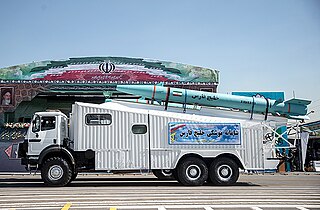 W
WThe Ghadr-110 is a medium-range ballistic missile designed and developed by Iran. The missile has a range of 1,800 km to 2,000 km. The Iranian Armed Forces first displayed the missile to the public at an annual military parade to mark the Iran–Iraq War.
 W
WThe Khorramshahr, named after the city of Khorramshahr in Iran, is a medium-range ballistic missile that was tested by Iran in January 2017. Its range is between 1,000–2000 km with a 1,800 kg warhead and is 13 m in length.
 W
WKhalij Fars is an Iranian single-stage solid-propellant, supersonic anti-ship quasi ballistic missile with a range of 300 km based on the Fateh-110 missile. It is equipped with a 650 kg explosive warhead and an interception evading guidance system.
 W
WThe Safir was the first Iranian expendable launch vehicle able to place a satellite in orbit. The first successful orbital launch using the Safir launch system took place on 2 February 2009 when a Safir carrier rocket placed the Omid satellite into an orbit with a 245.2 km (152.4 mi) apogee. Making Iran the ninth nation capable of producing and launching a satellite.
 W
WSedjil is an Iranian air-to-air missile, which is a "guided semiconductor radar", made in Islamic Republic of Iran Air Force ; which is in truth the changed-user of ground-to-air missile of HAWK. Sedjil's weight is approximately 500 kg, its length is 5 meters and its diameter is about 40 cm. The effective range of the missile is approximately 90 km. Its speed is estimated to be about 4-5 mach.
 W
WThe Shahab-3 is a quad-exhaust liquid-propelled medium-range ballistic missile (MRBM) developed by Iran and based on the North Korean Nodong-1. The Shahab-3 has a range of 1,000 kilometres (620 mi); a MRBM variant can now reach 2,000 kilometres (1,200 mi). It was tested from 1998 to 2003 and added to the military arsenal on 7 July 2003, with an official unveiling by Ayatollah Khamenei on July 20. With an accuracy of 140 m CEP, the Shahab-3 missile is primarily effective against large, soft targets. Given the Shahab-3’s payload capacity, it would likely be capable of delivering nuclear warheads. According to the IAEA, Iran in the early 2000s may have explored various fuzing, arming and firing systems to make the Shahab-3 more capable of reliably delivering a nuclear warhead.
 W
WZelzal-3 is an Iranian-made solid propellant unguided artillery rocket with a range of 200 km. It is an upgrade of the Zelzal-2 rocket with slightly improved range and was first shown to the public in 2007. A variant, the Zelzal-3B, has a smaller warhead and a range of 250 km. The shape and dimensions of the Zelzal-3 are nearly identical with previous versions except that the nosecone is cone shaped rather than the dome shaped Zelzal-2 and Zelzal-1. The Zelzal-3 has revived little use as the much more accurate Fateh-110 missile was also developed from the Zelzal-2.